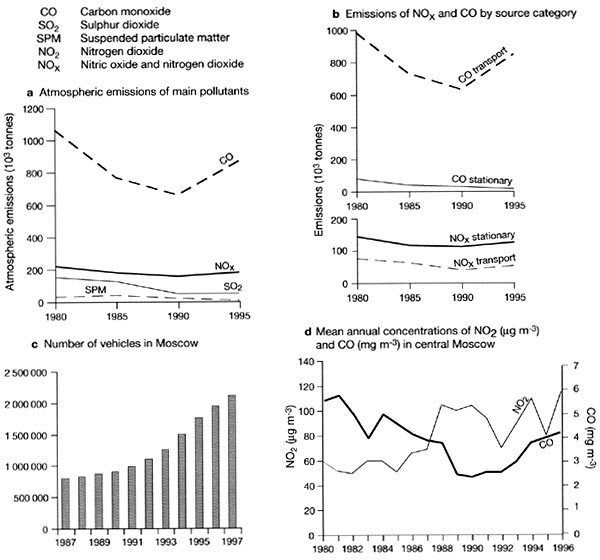Please put an active hyperlink to our site (www.rusnature.info) when you copy the materials from this page
Environmental problems of Northern Eurasia
Air Pollution
<<< Case Study. Air Pollution in the
Arctic: A Hazy Perspective | Environmental Problems Index |
Conclusions >>>
Case Study. Moscow: From Plan to Market in a Private Car
As recent studies have shown, environmental performance during the period of economic
transition has been regionally differentiated according to a range of interrelated factors
such as individual regions' preexisting socioeconomic structure, their resource base, and
attractiveness to foreign capital and the attitude of the regional leadership towards the
environment (Zamparutti and Gillespie, 2000). Moscow is a centre of reformist strategy, a
position it has secured as a result of a reformist leadership, the involvement of
international agencies in economic transformation, and an industrial structure which has
proved to be adaptable, in parts, to conversion and restructuring. If environmental
improvement associated with transition were to figure anywhere in the FSU, it would be
reasonable to expect it to do so in a high-profile city such as Moscow.
It has already been mentioned that although the largest, Moscow has never been the most
polluted city in the FSU. The first attempts to improve air quality in Moscow date back to
the 1960s when more than 600 polluting factories were closed down. Later, heating was
centralized which allowed the elimination of numerous low-level sources of pollution
universally known as major contributors to air pollution episodes. Subsequently, power and
heating plants have been converted to burn natural gas (a cleaner and cheaper fuel) which
at present accounts for 95 per cent of fuel burnt in the city (pp. above). Following this
transfer, emissions of SO2 and SPM have declined dramatically (Figure 21.11a).

Fig. 21.11 Characteristics of air pollution in Moscow
Power generation is still the main source of NOX in Moscow, contributing over 60 per
cent of total NOX emissions (Shahgedanova et al., 1999) and in order to reduce pollution
by NOX, low burners have been introduced extensively and successfully employing mainly
indigenous technologies, although international cooperation also played a part (Hill,
1997, 2000). Thus a reduction in pollution from stationary sources has been achieved and,
with regard to power generation, economic reforms and the policy of openness may encourage
the 'decoupling' between production and air pollution emissions in the future. While
energy efficiency has improved, the growth of car ownership associated with the transition
presents a major threat to the urban environment. A steady reduction in CO and NOX
vehicular emissions was observed in the city between 1980 and 1988, despite an increase in
car numbers following the introduction of newer engine designs, growth of diesel fuel
consumption and changes in driving patterns. However, since 1990 the number of cars has
increased dramatically leading to the growth of vehicular CO and NOX emissions and
concentrations (Figure 21.11). The vehicles are often old and poorly maintained; the
quality of fuels is also low in comparison with those used in the West (although the
widespread use of compressed natural gas in Moscow is undoutably beneficial). So far,
neither the federal environmental agencies nor the Moscow City Council has developed a
coherent transport strategy for the city. The Russian Law on Air Quality is aimed at power
generating and industrial sources (Shahgedanova and Burt, 1993), which in previous years
were the major sources of pollution across the country. In the absence of controls,
Moscow, as so many other European cities, now faces a serious problem with regard to
vehicular pollution.
<<< Case Study. Air Pollution in the
Arctic: A Hazy Perspective | Environmental Problems Index |
Conclusions >>>
Contents of the Air Pollution section:
Other sections of Environmental Problems of Nortern Eurasia:
|
|